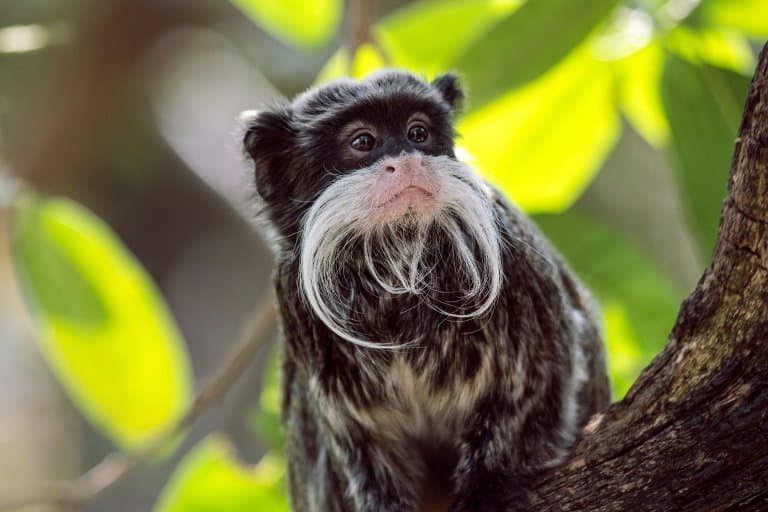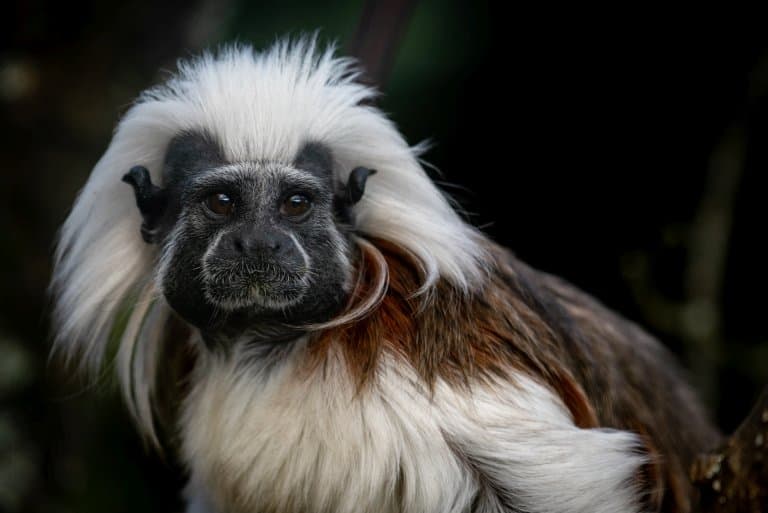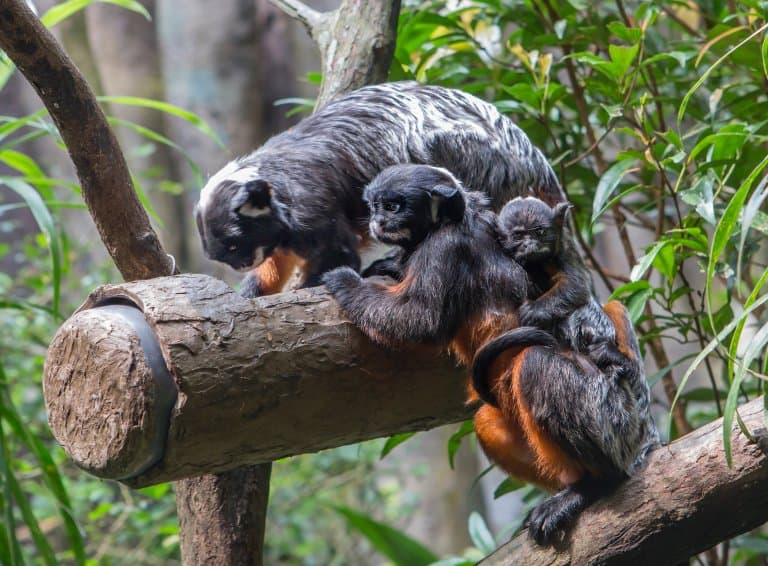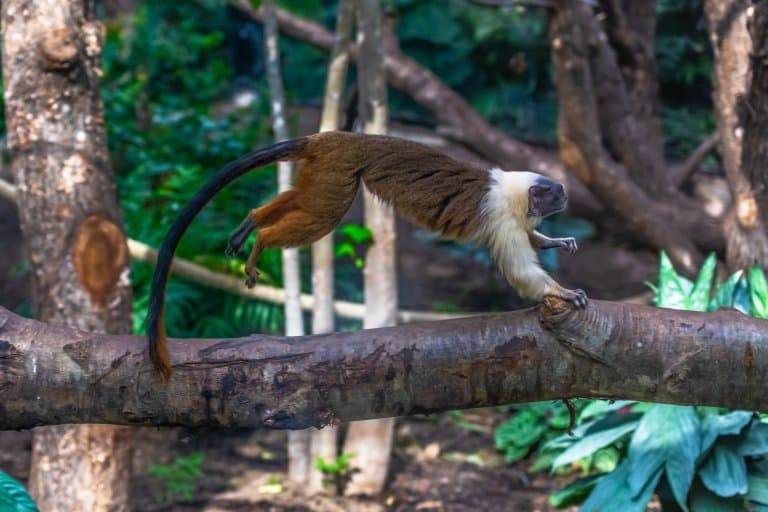Tamarin Profile
Tamarins are a group of small tree-dwelling New World monkeys that largely inhabit tropical rainforests.
They have dexterous hands with non-opposable thumbs and long tails that can measure up to 17 inches in length.

Tamarin Facts Overview
| Habitat: | Tropical rainforests, mountain forests, and regions |
| Location: | Southern & Central America |
| Lifespan: | Approximately 15 years in the wild |
| Size: | 5 – 12 inches (body), 10 – 17 inches (tail) |
| Weight: | 350 – 600 grams |
| Color: | Black, brown, white, maroon, tan, grey |
| Diet: | Fruit, insects, nectar, leaves, flowers |
| Predators: | Snakes, birds of prey, wild dogs, and cats |
| Top Speed: | 40 kph (25 mph) |
| No. of Species: |
22 (19 subspecies) |
| Conservation Status: |
Dependent on the species (range from unknown to decreasing) |
There are 22 species of tamarin in the genus Saguinus and are closely related to lion tamarins, Goeldi’s monkeys, and marmosets.
Most are brown, dark red, or black, and some have colorings that make them look like they have mustaches. They are squirrel-sized, ranging from 5-12 inches in body length, with a tail that can almost double it up to 17 inches in length.
They live in family groups known as troops typically made up of 3-9 members in the trees. They are exceptional climbers and extremely agile, able to run and jump with ease through the canopy.
Their canine-like teeth and sharp claws make them effective hunters and foragers. As omnivorous animals, tamarins consume a variety of fruits, leaves, nectar, and insects. In captivity, they can thrive on sweet potatoes, eggs, crickets, and vegetables such as green beans.
The conservation status of some tamarins is unknown; however, due to poaching and deforestation, some populations are, unfortunately, on a steady decline.
Interesting Tamarin Facts
1. Tamarins help forests flourish
After consuming fruits, tamarins will excrete seeds through their faeces and spread them through the forest. The excrement acts as a nutritious fertilizer for the seeds, which will germinate and develop into new trees 1

2. They live in exceptionally social family groups
Tamarins live in social groups that include parents, offspring, and other tamarins who have migrated from other groups. They can join groups that live in troops of up to 40 members, though typically they are much smaller.
Together, they collaborate to protect the group from predators and look for new food sources.
3. Vocalizations allow tamarins to work as a team
To inform the group about predators, tamarins release specific calls and sounds. They also use vocalizations to warn intruders not to encroach on their territory.
Tamarins are thought to have over 38 different types of vocalizations.

4. Grooming is used as a way to bond
Tamarins are routinely seen practicing social grooming. In addition to keeping their coats healthy, these grooming rituals create strong bonds between group members.
5. Breeding relationships are polyandrous
In many species, there exists a polyandrous mating system. This means that one dominant female will mate with multiple males within the group.

6. Different species can coexist in harmony within the same space
Emperor tamarins have been observed living with Saddleback tamarins within the same trees.
Emperor tamarins lived in the higher branches while the Saddlebacks inhabited levels closer to the ground. Both species were on the lookout for mutual predators and would help the other escape.
7. Tamarins are diurnal animals
Most active during the daytime, tamarins are categorized as diurnal animals. Most primates are diurnal.
8. Males actively participate in the rearing of their young
Fathers care for their offspring and have even been found assisting mothers during birth. They will share in the rearing of young tamarins through their early stages of development.
9. Young tamarins are heavy at birth
Tamarins are usually born in pairs, and they are unexpectedly heavy at birth, weighing in at almost 20 percent of their mother’s body weight.
10. They are incredibly intelligent
In a study conducted at Harvard University, tamarins displayed impressive abilities in a series of intelligence tests. They exhibited remarkable abilities in tasks that required working memory, information processing, and executive control 2
11. Their tails cannot be used to grab objects
Tamarin tails are not prehensile, meaning they cannot use them to grasp or hang onto objects. Their long tails do however help them balance as they leap from branch to branch.

12. Vaccines have been used to protect select populations
Some populations of tamarin have been vaccinated against certain viruses. These vaccination programs are meant to protect not only tamarin species but humans that live locally as well. 3
13. Some species are still traded as pets
Despite it being an illegal practice, some tamarins are still hunted and sold as pets around the world. Continuous conservation efforts are in place to reduce these exchanges.
14. They have many threats from above and below
Due to their small size, they have plenty of predators from both mammals on the ground, animals in the trees and above in the air.
Snakes, birds of prey, wild dogs, and cats are all known to prey on tamarins!
Tamarin Fact-File Summary
Scientific Classification
| Kingdom: | Animalia |
| Phylum: | Chordata |
| Class: | Mammalia |
| Order: | Primates |
| Family: | Callitrichidae |
| Genus: | Saguinus |
| Subgenus: | Saguinus, Tamarinus |
| Species: | Golden-handed tamarin Western black-handed tamarin Eastern black-handed tamarin Pied tamarin Martins’s tamarin Martins’s bare-face tamarin Ochraceus bare-face tamarin Cotton-top tamarin Geoffroy’s tamarin White-footed tamarin Moustached tamarin Spix’s moustached tamarin Red-capped tamarin White-rump moustached tamarin White-lipped tamarin Geoffroy’s red-bellied tamarin Thomas’s red-bellied tamarin Gray’s red-bellied tamarin Emperor tamarin Black-chinned emperor tamarin Bearded emperor tamarin Mottle-faced tamarin |
Fact Sources & References
- Joel Saratore, “Cotton-top tamarin“, National Geographic.
- Amy Lavole (2019), “Individual primates display variation in general intelligence“, The Harvard Gazette.
- “Golden Lion Tamarins“, Save the Lion Tamarin.
